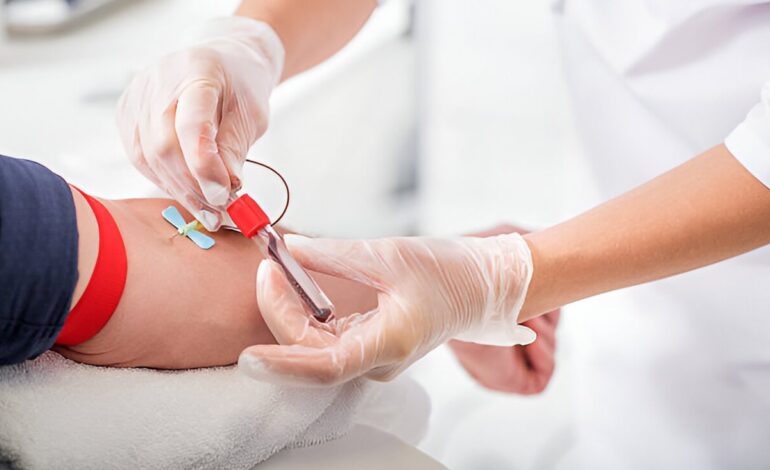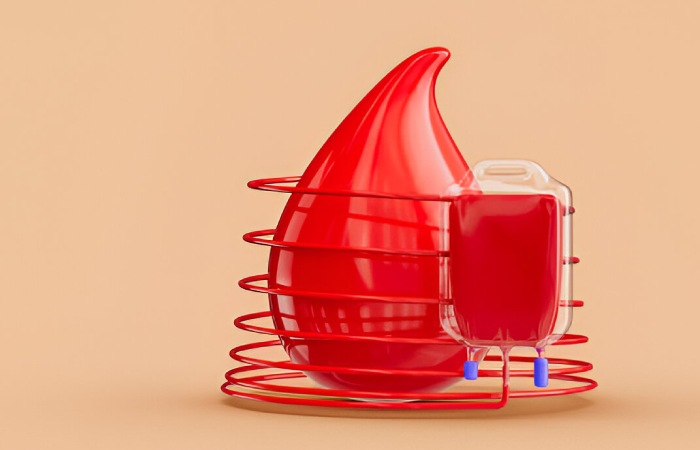How Many Pints Of Blood Are In The Human Body?

The number of pints of blood in the human body is 10.5 pints. There are around 10.5 pints of blood in the regular human adult body, but this can vary based on a person’s age and size. It accounts for around 7–8% of an adult’s body weight. A person can drop around one pint without causation any harm to the body.
How Many Pints of Blood Are in the Human Body?

The quantity of blood in the human body does, of course, depend on the human! A person’s age, sex, body size, and general health affect their blood volume. On a regular, though, the adult human body contains around 10.5 pints of blood. Put an additional way, that’s about five liters or 1.3 gallons.
To put those numbers into setting, that’s anywhere around 8-10% of the regular adult’s body weight. Regular human adults have nearly 8-10 pints of blood in the human body, which is 8% of the body’s weight. A pint of blood is equal to 473.18 mL.
Men vs. Women
Men typically have more blood than women due to their usually greater body size and muscle mass. Notably, pregnant women are an outlier, with a blood volume rise of roughly 50%!
Newborn Babies
The regular newborn only has about a sector of a liter of blood, amounting to unevenly half a pint.
Children (6-12)
Like adults, children in this age group have around 70 mLs of blood per kg. That means that a 66-pound child would have about 2 liters of blood mingling in their body.
Composition of Blood
Plasma
Blood plasma is an intravascular liquid constituent of blood after blood cell removal. Plasma holds proteins and other mechanisms of the blood in suspension. It types up about 55% of the body’s total blood volume.
Plasma is 95% water and contains significant dissolved proteins, like serum albumins, globulins, and fibrinogen), glucose, coagulation factors, electrolytes (Na+, Ca2+, Mg2+, HCO3-, Cl-, etc.), hormones, carbon dioxide, and oxygen (which types up about 6%-8%). It has an intravascular osmotic result that maintains the equilibrium of electrolytes and defends the body from infection and other blood disorders.
Blood Cells
About 50% of blood comprises three main groups of blood cells: platelets, red blood cells, and white blood cells. Most blood cells are shaped by a single type of unspecialized cell current inside the soft fatty tissue of the bone cavity.
Red blood cells comprise hemoglobin, which brings oxygen to tissues and helps them continue operating correctly.
White blood cells share the immune system and are of five different kinds: neutrophils, lymphocytes, monocytes, eosinophils, and basophils. These assistants protect against infections and have a role in irritation and allergic reactions.
Platelets are smaller cells that play a vital role in blood clotting and the closure of micro punctures in the body.
The rate of blood cell production is skillful by demand. The characteristic lifespan of blood cells ranges from a few hours to beings for white blood cells, around 10 days for platelets, and about 120 days for red blood cells.
Proteins
Plasma proteins help various significant functions, including the carriage of lipids, hormones, vitamins, and minerals throughout. Some proteins act as enzymes, complement mechanisms, protease inhibitors, or kinin precursors. The three key plasma proteins include albumin, globulin, and fibrinogen.
Serum albumin types up about 55% of blood proteins. It maintains the oncotic pressure of plasma (stops body swelling and saves fluids in the vascular section) and acts as a carrier molecule for the conveyance of lipids and steroid hormones.
Globulins type up about 38% of blood proteins. They help convey ions, hormones, and lipids and are essential to the body’s protection system.
Fibrinogen types about 7$ of blood proteins, and its change to insoluble fibrin is essential for blood clotting.
The remaining plasma proteins (1%) control proteins, such as enzymes, proenzymes, and hormones. Blood proteins are typically synthesized in the liver.
Nutrients and Hormones
Blood plays a part in the functions of the endocrine system. Nutrients counting glucose, amino acids, vitamins, minerals, and fatty acids are engrossed in the bloodstream through capillaries in intestinal villi. These nutrients are elated along with blood to numerous organs of the body. Blood also acts as a conveyance medium for hormones concealed by the endocrine system’s glands and assists them in reaching their target site so that they can transmit their actions.
How Much Do You Have to Weigh to Donate Blood?
You may also be interested in potential weight supplies for eligible donors. A fair question! Under FDA rules:
- Donors over the stage of 17 must be at least 110 pounds.
- Sixteen-year-olds can give blood if they weigh 125 pounds with consent from a parent or carer.
- Seventeen-year-olds can spring blood if they are over 125 pounds but do not have essential permission from a guardian or parent.
Conclusion
Blood volume varies based on age, weight, and sex. An adult male about 6 feet tall, weighs about 200 pounds, and has about 12 pints of blood. The bone marrow produces the cellular components of blood—red blood cells, white blood cells, and platelets.
Medical interventions, such as blood transfusions, might be needed if bleeding reduces blood volume significantly, which can produce shock. Laboratory testing and physical examination can determine the extent of blood loss and the required interventions.
Check this website: https://www.hlffitness.com/